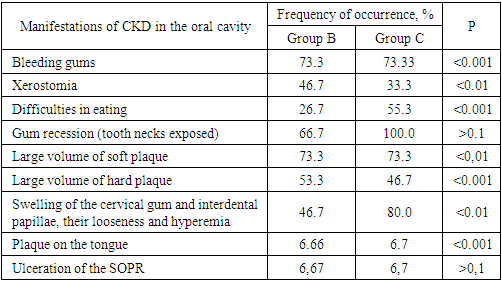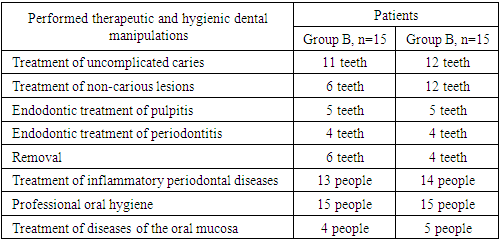| [1] | Lomova A.S., Moroz P.V., Prokhodnaya V.A. Features of antimicrobial immunity of the oral cavity in pregnant women with primary and recurrent caries // Scientific review. Medical sciences. – 2014. – No. 2. – pp. 44-45. |
| [2] | Malyshev M.E., Lobeyko V.V., Iordanishvili A.K. Immune indicators of saliva in people of different ages living in St. Petersburg and the Leningrad region // Successes of gerontology, 2015. Vol. 28, No. 2. pp. 294-298. |
| [3] | Abdinian M, Mortazavi M, Jandaghian Z. Comparison of skeletal changes related to patients with chronic kidney disease and healthy individuals in digital panoramic radiography. Indian J Dent Res 2019; 30: 358-62. |
| [4] | Anuradha B.R., Katta S., Kode V.S., Praveena C., Sathe N., Sandeep N., et al: Oral and salivary changes in patients with chronic kidney disease: A clinical and biochemical study: J Indian Soc Periodontal. 2015; 19: 297-3. |
| [5] | Brotto R.S., Vendramini R.C., Brunetti I.L., Marcantonio R.A., Ramos A.P., Pepato M.T.: Lack of correlation between periodontitis and renal dysfunction in systemically healthy patients. Eur J Dent. 2011; 5: 8-18. |
| [6] | Chambrone L., Chambrone D., Pustiglioni F.E., Chambrone L.A., Lima L.A.: The influence of tobacco smoking on the outcomes achieved by root-coverage procedures. A systematic review. J Am Dental Assoc. 2009; 140: 294–6. |
| [7] | Chambrone L, Foz AM, Guglielmetti MR, Pannuti CM, Artese HP, Feres M, Romito GA. Periodontitis and chronic kidney disease: a systematic review of the association of diseases and the effect of periodontal treatment on estimated glomerular filtration rate J Clin Periodontol 2013, 40: 443-456. |
| [8] | Costantinides F., Castronovo G., Vettori E., Frattini C., Artero M.L., Bevilacqua L., et al: Dental Care for Patients with EndStage Renal Disease and Undergoing Hemodialysis. International Journal of Dentistry Volume. 2018| doi.org/10.1155/2018/9610892. |
| [9] | Craig RG. Interactions between chronic renal disease and periodontal disease Oral Dis 2008; 14: 1-7. |
| [10] | Dağ A., Firat E.T., Kadiroğlu A.K. et al. Significance of elevated gingival crevicular fluid tumor necrosis factor-alpha and interleukin-8 levels in chronic hemodialysis patients with periodontal disease. J Periodontal Res 2010; 45:4: 445—450. |
| [11] | Davidovich E., Schwarz Z., Davidovitch M. et al. Oral findings and periodontal status in children, adolescents and young adults suffering from renal failure. J Clin Periodontol 2005; 32: 10: 1076—1082. |
| [12] | Dioguardi M., Caloro G.A., Troiano G., Giannatempo G., Laino L., Petruzzi M., et al: Oral manifestations in chronic uremia patients. Ren Fail. 2016; 38(1): 1-6. |
| [13] | Dirschnabel A.J., Martins Ade S., Dantas S.A. et al. Clinical oral findings in dialysis and kidney-transplant patients. Quintessence Int 2011; 42: 2: 127-133. |
| [14] | Ellis J.S.: New year challenges: major challenges facing today's leaders of dental education. Eur J Prosthodont Restor Dent. 2004; 12: 143. |
| [15] | Gaál Kovalčíková A, Pančíková A, Konečná B, Klamárová T, Novák B, Kovaľová E, Podracká Ľ, Celec P, Tóthová Ľ. Urea and creatinine levels in saliva of patients with and without periodontitis. Eur J Oral Sci. 2019 Oct; 127(5): 417-424. doi: 10.1111/eos.12642. |
| [16] | Garcez J., Limeres Posse J., Carmona I.T. et al. Oral health status of patients with a mild decrease in glomerular filtration rate. Oral Surg Oral Med Oral Pathol Oral Radiol Endod 2009; 107: 2: 224—228. |
| [17] | Gavalda C, Bagan J, Scully C, Silvester F, Milian M, Jimenez Y. Renal hemodialysis patient; oral, salivary, dental and periodontal findings in 105 adult cases. Oral Dis. 1999; 5: 299–302. |
| [18] | Granitto M, Fall-Dickson J, Norton C, Sanders C. Review of therapies for the treatment of oral chronic graft-versus-host disease. Clin J Oncol Nurs. 2014; 18: 76–81. |
| [19] | Grubbs V., Plantiga L.C., Tuot D.S., Powe N.R.: Chronic kidney disease and use of dental services in a United States public healthcare system: a retrospective cohort sudy. BMC Nephrol. 2012; 13: 16. |
| [20] | Kaswan S, Patil S, Maheshwari S, Wadhawan R. Prevalence of oral lesions in kidney transplant patients: A single center experience. Saudi J Kidney Dis Transpl 2015; 26: 678-683. |
| [21] | Levey A, Eckkardt K, Tsukamoto Y, Levin A, Coresh J, Rossert J, et al. Definition and classification of chronic kidney disease; a position statement from kidney disease improving global outcome. Kidney Int. 2005; 67: 2089–100. |
| [22] | Lucas V.S., Roberts G.J. Oro-dental health in children with chronic renal failure and after renal transplantation: a clinical review. Pediatr Nephrol 2005; 20: 10: 1388—1394. |
| [23] | Nylund KM, Meurman JH, Heikkinen AM, Furuholm JO, Ortiz F, Ruokonen HM. Oral health in patients with renal disease: a longitudinal study from predialysis to kidney transplantation. Clin Oral Invest. 2017; doi 10.1007/s00784-017-2118-y. |
| [24] | Oyetola EO, Owotade FJ, Agebelusi GA, Fatusi OA, Sanusi AA. Oral findings in chonic kidney disease: implications for management in developing countries. BMC. 2015; 15: 24-31. |
| [25] | Proctor R, Kumar N, Stein A, Moles D, Porter S. Oral and dental aspect of chronic renal failure. J Dent Res. 2005; 84: 199–208. |
| [26] | Simpson T.C., Needleman I., Wild S.H., Moles D.R., Mills E.J.: Treatment of periodontal disease for glycaemic control in people with diabetes. Cochrane Database Syst Rev. 2010; 12 (5): CD004714. |



 Abstract
Abstract Reference
Reference Full-Text PDF
Full-Text PDF Full-text HTML
Full-text HTML










